WAITING, SITTING, LYING, LAYING Caroline Lillian Schopp on the Sculptural Vocabulary of Lydia Nobles
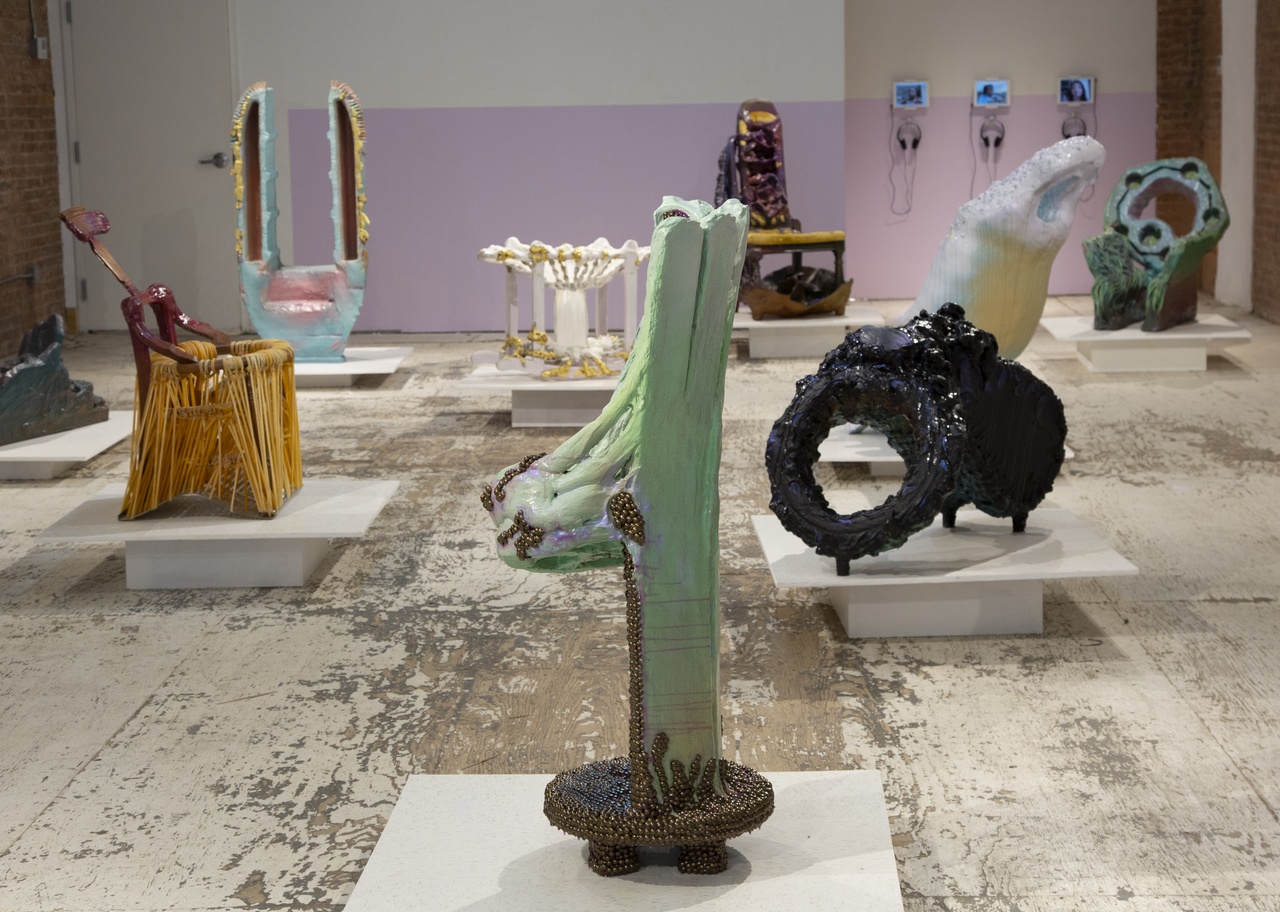
“Lydia Nobles: As I Sit Waiting,” Ross-Sutton Gallery, New York, 2022
Unabashedly anthropomorphic yet without figuration, each of the remarkable nineteen sculptures that comprise Lydia Nobles’ in-progress series As I Sit Waiting tells an abortion story. Each sculpture in the series is named after someone who has had an abortion. Presented on iPads with earphones, Nobles’ conversations with each person capture their vulnerability and resilience in the words they use to describe deciding to undergo an abortion in the United States. [1] In stark contrast with the narrative form of the interviews, each sculpture in its candid materiality proposes a posture. They are uncanny chairs – rockers, little benches, recliners – that imply lingering positions of inclination and provoke empathetic response, ranging from discomfort, fear, pain, and loss to relief, exuberance, and liveliness. Waiting, sitting, lying, laying: these are the key terms of Nobles’ sculptural vocabulary.
Scarlett (2022) is a low backless seat, coated in an iridescent opal glaze, its underside thickened with a layer of vibrant red acrylic. The sculpture is recumbent, squat, inert, unobtrusive yet captivating in its visual heterogeneity. Little protuberances, dipped in thin fuchsia and iodine-yellow paint, jut from an opening below the seat, just where – were it taken as such – one would grasp it to lift one’s bottom. Scarlett inhibits the very action it anticipates, generating a dual sense of physical unease and invitation. Around the base of Claudia (2022), shallow cavities shaped in acrylic latex blossom and atrophy. Their interiors are patinated in gold leaf, and their outer surfaces are coated in shimmering layers of green and lavender. A translucent plastic hose, leaning against an upturned commode, circles through it. Though composed vertically, the unwieldy appendages of Claudia seem to tip over and drain out, vivacious openings collect around defunct circuitry, rows of stubby tendrils press out defiantly behind it. In Nobles’ sculptural work, “the most pregnant moment” is one of abortion.
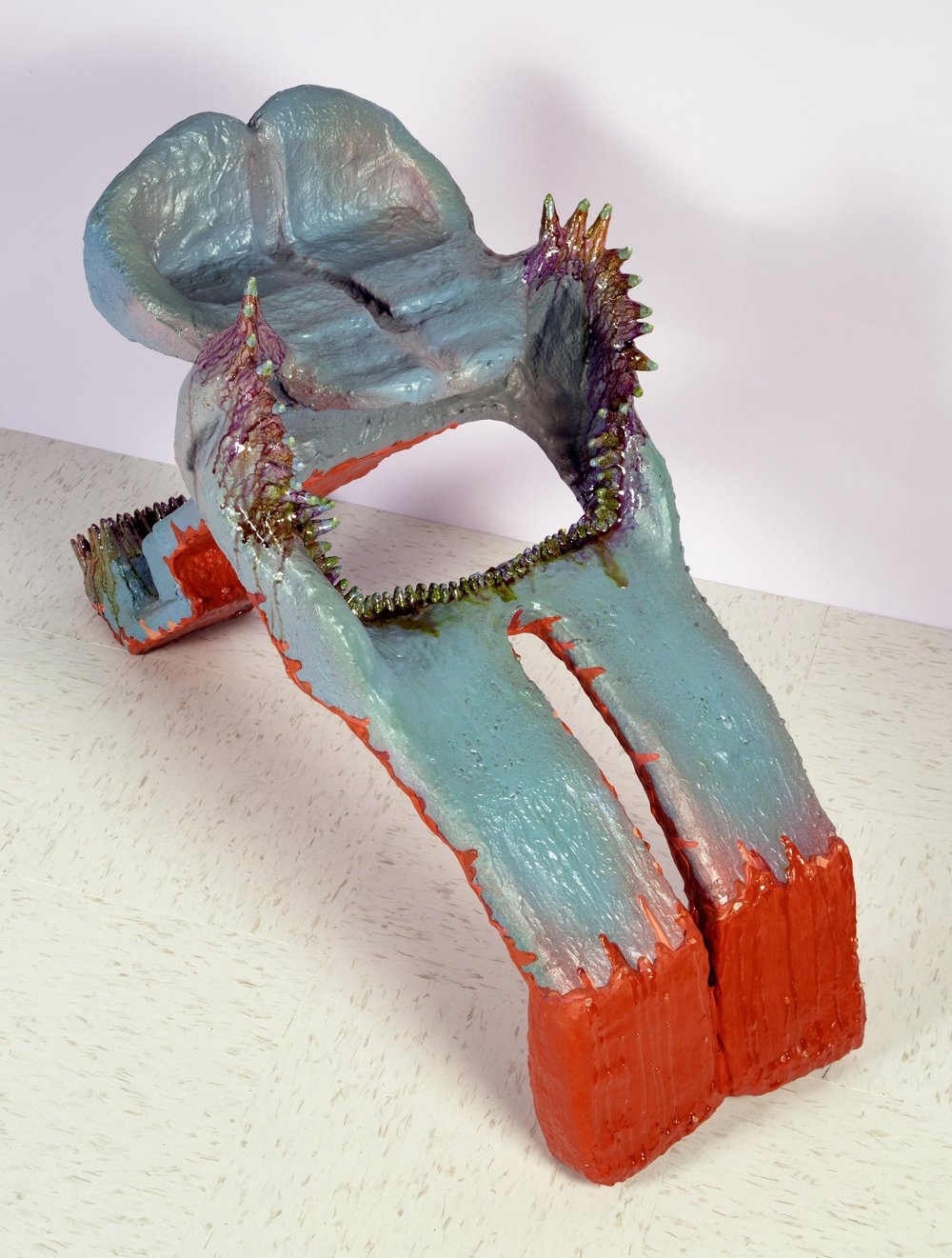
Lydia Nobles, “Scarlett,” 2022
Gotthold Ephraim Lessing defined the art of sculpture as that of “the most pregnant moment,” a phrase referring to the arresting confluence of physicality and temporality captured in the medium’s most outstanding works. His example, famously, is the life-size marble sculpture Laocoön and His Sons (c. 200 BCE–70 CE). As serpents twist around the supple bodies of his children, binding them to and rending them from him with the same deadly coils, Laocoön arches upwards in anguish, his musculature taut with resistance, his mouth open as though to scream. This passionate scene of parental loss, pain, impotence, and imminent death has been a cornerstone of the art history of sculpture ever since. To follow Lessing’s argument in Laocoön: Or, on the Limits of Painting and Poetry (1766), while the lyric arts represent history by articulating sounds in time and setting “actions” into consecutive relation, the visual arts represent history with figures and colors in space by juxtaposing “bodies with their visible qualities.” [2] The task of the poet or the sculptor is to work within the limits of their medium, but such work can only be outstanding if it tests these limits at the same time. Thus, a sculpture should not imitate the means of poetry to represent history. With regard to Laocoön and His Sons, Lessing marvels at the ancient sculptors’ decisive departure from the poetic script. Instead of showing the serpents strangling the three figures’ torsos and necks, the coils are repositioned to the figures’ limbs and feet, accentuating their facial expressions and physical affect. For Lessing, this provides just the right “hint” of time and action necessary for the effective composition of bodies in space. The sculpture’s tense sense of “inhibited flight and a kind of inertia,” captured above all in Laocoön’s silently suffering face, epitomizes “the most pregnant moment.” I see Nobles as pushing these very limits of the medium of sculpture – in a decisively unmonumental, anti-patriarchal, queer-feminist direction. Her work viscerally reorients the gendered and postural conventions that inform sculpture’s history.
Nobles taps into the physicality, spatial constraint, and “inertia” constitutive of Lessing’s definition of the art of sculpture, without, however, relying on figuration in any traditional sense. She painstakingly reconceives of “bodies with their visible qualities.” Her sculptural materials and techniques of assemblage resonate with aspects of the work Lucy Lippard gathered in 1966 under the phrase “eccentric abstraction,” referring to the “near-visceral identification with form” solicited by sculptures like those of Eva Hesse or Louise Bourgeois. [3] When Hesse made her Laocoön (1965–66), she derived the sculpture’s abstract form – a narrow ten-foot-high caged ladder of papier-mâché over plastic plumbers’ pipe – as much from the upward-striving bodies of the figures as from the snakes. Loops and coils of cloth-covered cord, painted like the ladder in a matte gray acrylic, languish ominously from the latticework. One both indulges and abhors the thought of touching, or even occupying it. Nobles shares Hesse’s interest in materialities whose tensile strength also tends to tangle or droop – in detumescence, so to say. However even more than Hesse’s Accession series (1967–68) – open cubes of punctured steel, filled with short lengths of vinyl or rubber tubing pushed through each puncture – or her Washer Table (1967) – a low square metal table on which countless rubber washers are laid out – Nobles’ work sustains within abstraction a specific sense of corporeal inclination. It accentuates overlooked and understated postural comportments associated with disparaged, often depoliticized, and in every sense “patient” forms of life – waiting, sitting, lying, laying. The eccentricity of As I Sit Waiting lies in this inclinicity.
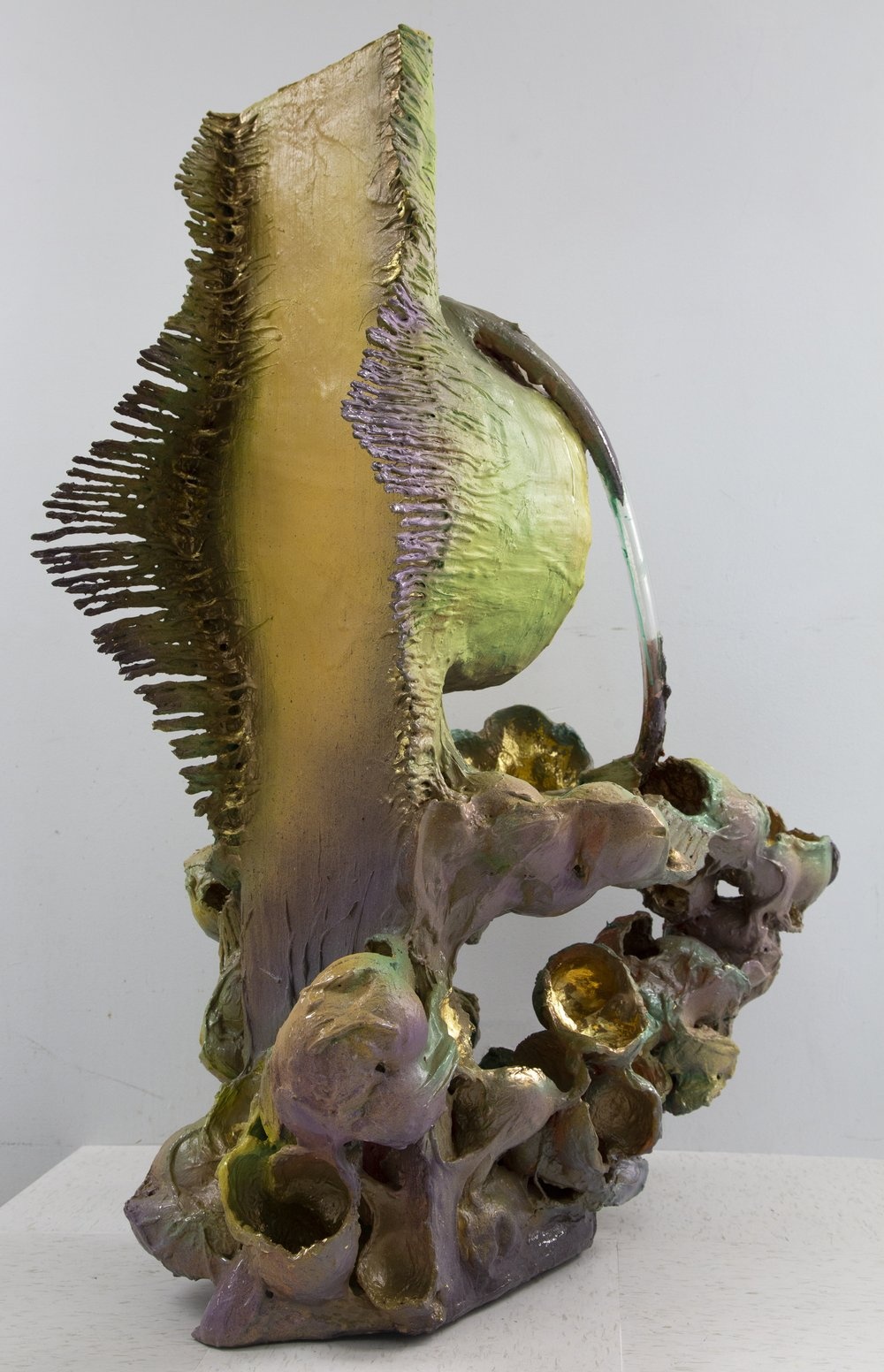
Lydia Nobles, “Claudia,” 2022
How to arrest “the most pregnant moment” in an “action” as widely pervasive yet historically downplayed as abortion? Or to put this another way: How might the artist approach history (to recall Lessing) not as “actions” undertaken, but as treatments that one must be strenuously proactive to receive, even if they are often taken lying down? In the United States, such questions have become once again sadly all the more urgent. Since she began As I Sit Waiting in 2019, the drastic disparity in the availability of abortion care across the country has been made even more acute by the US Supreme Court’s decision in June 2022 that the right to abortion is not “implicit in the concept of ordered liberty,” and should not be protected because “a right to abortion is not deeply rooted in American history and tradition.” [4] Nobles’ work was censored in March 2023. For the group exhibition “Unconditional Care: Listening to People’s Health Needs” at Lewis-Clark State College, in Lewiston, Idaho, Nobles included only her interviews with the people after whom the sculptures Blair (2021), Cat (2022), and DeZ’ah (2022) are named. On the spurious basis that to simply speak about abortion is “to promote” it, the interviews were removed from the show. [5] This censorship shows how narrative, as the aesthetic and social medium through which action is conventionally represented, is most vulnerable to cultural hypocrisy.
Would the sculptures have been censored had they been included in the show? Based on Idaho’s “No Public Funds for Abortion Act,” it unfortunately seems all too likely. The censors would not, however, have been able to make their case on the basis of the stories told, but rather on the specifically sculptural qualities of the work. They would, ironically, have had to affirm what makes Nobles’ sculptures outstanding: the way they capture the most pregnant moment of abortion in its physical, emotional, and historical complexity. They maintain space for the inclined bodies of those who are not granted the freedom, liberty, and justice – and in turn, solicitude – accorded to others whose actions continue to define national “history and tradition,” perpetuating the myths on which these are built.
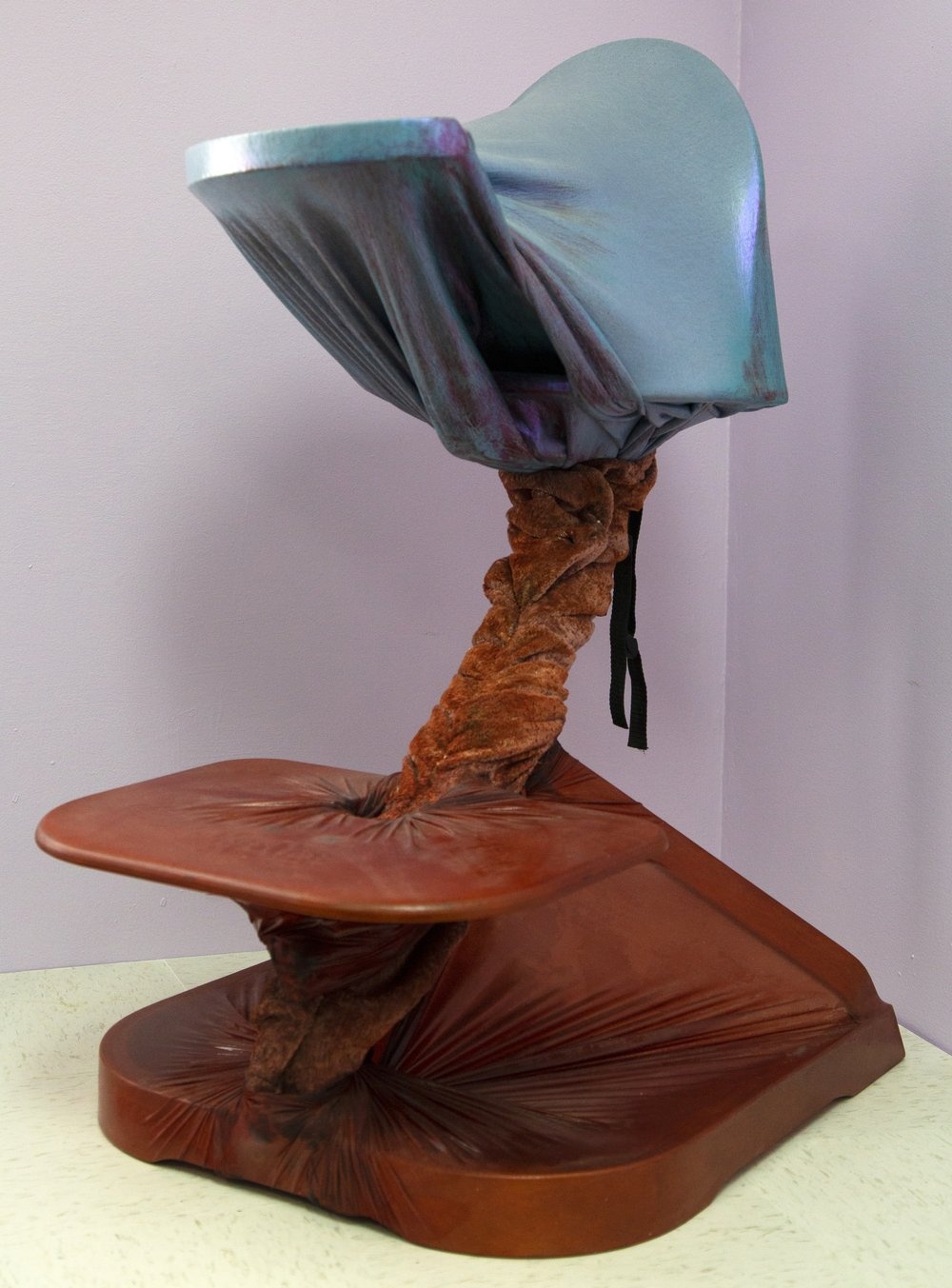
Lydia Nobles, “Blair,” 2021
As I Sit Waiting began with Lydia (2019). Within the seatless frame of a broad wooden chair, pale pink rubber piping insulation coils tightly around a six-inch nut and bolt. Squeezed between two discs of transparent plexiglass, this cumbersome circular construction is suspended with two lengths of latex tubing that pass through the coils and loop around the chair, arm to arm, seat to back. It is an utterly arresting work. Temperance (2021) shares Lydia’s palpable inertia. Lengths of latex tubing are stretched and bound around a seatless chair, pulled taut through a perforated metal sheet beneath it, and tied off in thick knots at each juncture. The twisting extension of the latex tubing is tempered by the prostrate position afforded by the form of the chair. Above its cramped yet empty interior, mounds of resin accentuate the incline of its backrest. These sculptures do not explicitly disclose that Lydia was prompted by the experience of the artist’s own abortion, or that Temperance is related to the experience of a non-binary person who was serving in the US Navy. With great compassion and clarity, Nobles’ interviews address gender, adoption, drug use, sexual violence and abuse, institutional services and neglect, medical conditions, costs of living, recovery and support systems, and many other important issues that belong to unique stories of abortion. The sculptures show something else – something missing from yet underlying the politicized discourse on abortion.
The materials Nobles choses and the exhibition venues she seeks out provocatively situate her work in present circumstances. She salvages many of the seats and chairs she uses from the streets of New York City. Walking late one night with her dog, Nobles saw the highchair that would become Blair in the distance, “just screaming at me.” With her free arm, she “painfully carried it home.” [6] Blair gets at the dual violence and tenderness of inclination. Its seat twists around its axis, while its surfaces are partially wrapped in thin opalescent fabric, pulled taut enough to puncture, and partially in lengths of supple brown velour. The chair in Lydia is from the waiting room of Planned Parenthood in Manhattan. In January 2023, the sculpture was installed at the Brooklyn Museum for the program “50 Years Since Roe: A Convening on Reproductive Justice – Abortion Stories USA.” Visitors to the 2024 Venice Biennale will find Temperance in the European Cultural Centre as a part of the satellite exhibition “Unapologetic WomXn: The Dream is the Truth,” curated by Destinee Ross-Sutton. Lymariz (2022) now sits on site at Planned Parenthood in Cincinnati, donated after a charitable auction. The sculpture suspends a seat from an obliquely angled clasp, between and beneath which strands of rubber – painted in Nobles’ characteristic palette of fleshy-pink and medusa-green acrylic – amass formlessly. On the seat, an abject opening secretes a beautiful amalgam of gemstone colors.
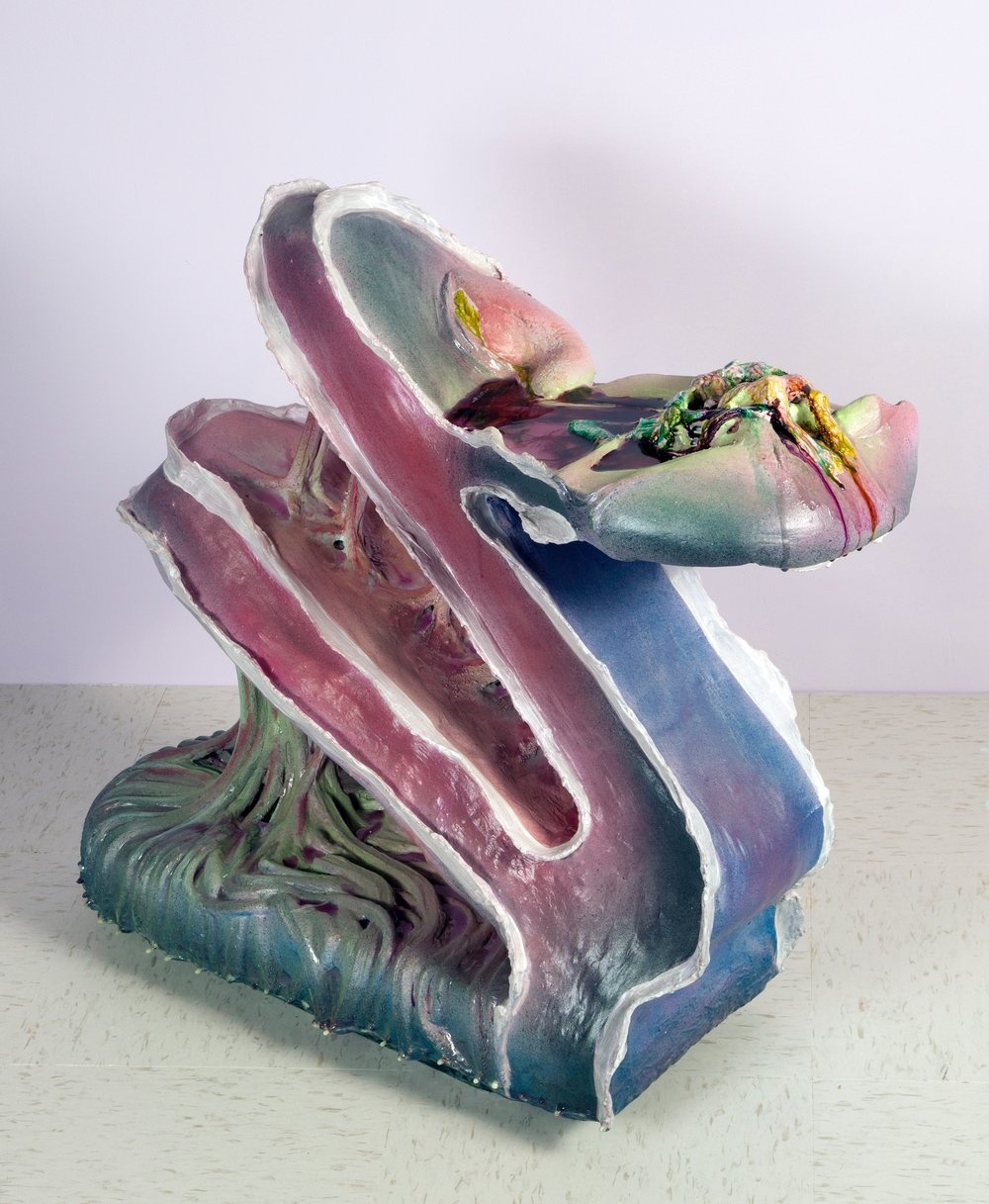
Lydia Nobles, “Lymariz,” 2022
In a thoughtful discussion of the series and her work, Nobles mentions that the title As I Sit Waiting alludes to William Faulkner’s novel As I Lay Dying of 1930. [7] Some may, as I did, think first of Cash, who spends much of the narrative lying on top of his mother’s coffin after breaking his leg on the mishap-ridden journey to bury her. Rather than see a doctor, his family decides to encase his leg in cement so as not to further waylay their progress. This cast forms part of Faulkner’s devastating sculptural assemblage of familial obligation. But As I Lay Dying is, of course, also an abortion story. Cash’s sister Dewey Dell is pregnant. When the doctor comes, weeks too late, to visit their dying mother, Dewey Dell thinks silently to herself, “He could do so much for me if he just would.” [8] She does not speak to him. She just cannot. As Heather Holcombe observes, in the period in which Faulkner wrote, a “lack of vocabulary and a reluctance to engage in conversation that requires the use of ‘vulgar, men’s words’” inhibited especially impoverished rural women from articulating the need or wish for an abortion. [9] On the dreadful journey to bury her mother, the first druggist Dewey Dell visits berates and threatens her, the second gives her turpentine, six capsules of talcum powder, and rapes her. She knows he’s sold her a lie. [10]
Evoking the marginal story in Faulkner’s novel, Nobles’ sculptures contribute to a long if understated – I want to say under-lying – tradition of telling abortion stories in the US. Think of Joan Didion’s Play It As It Lays (1970), published three years before the ratification of Roe v. Wade. Although not at its center, the novel arguably turns on the story of Maria’s illegal abortion. Maria tries “not to think of dead things and plumbing.” She sees “ominous coils” in her food, a “rattlesnake in the playpen.” In an inconspicuous house in the California suburbs, she is laid out on a makeshift table, which “was a doctor’s table but not fitted with stirrups: instead there were two hardbacked chairs with pillows tied over the backs.” “Don’t scream Maria,” she is cautioned, “there are people next door.” Afterwards, she “smiled radiantly.” [11] Nobles’ sculptures capture the moment that narrative can only indicate between “don’t scream” and “smiled radiantly.”
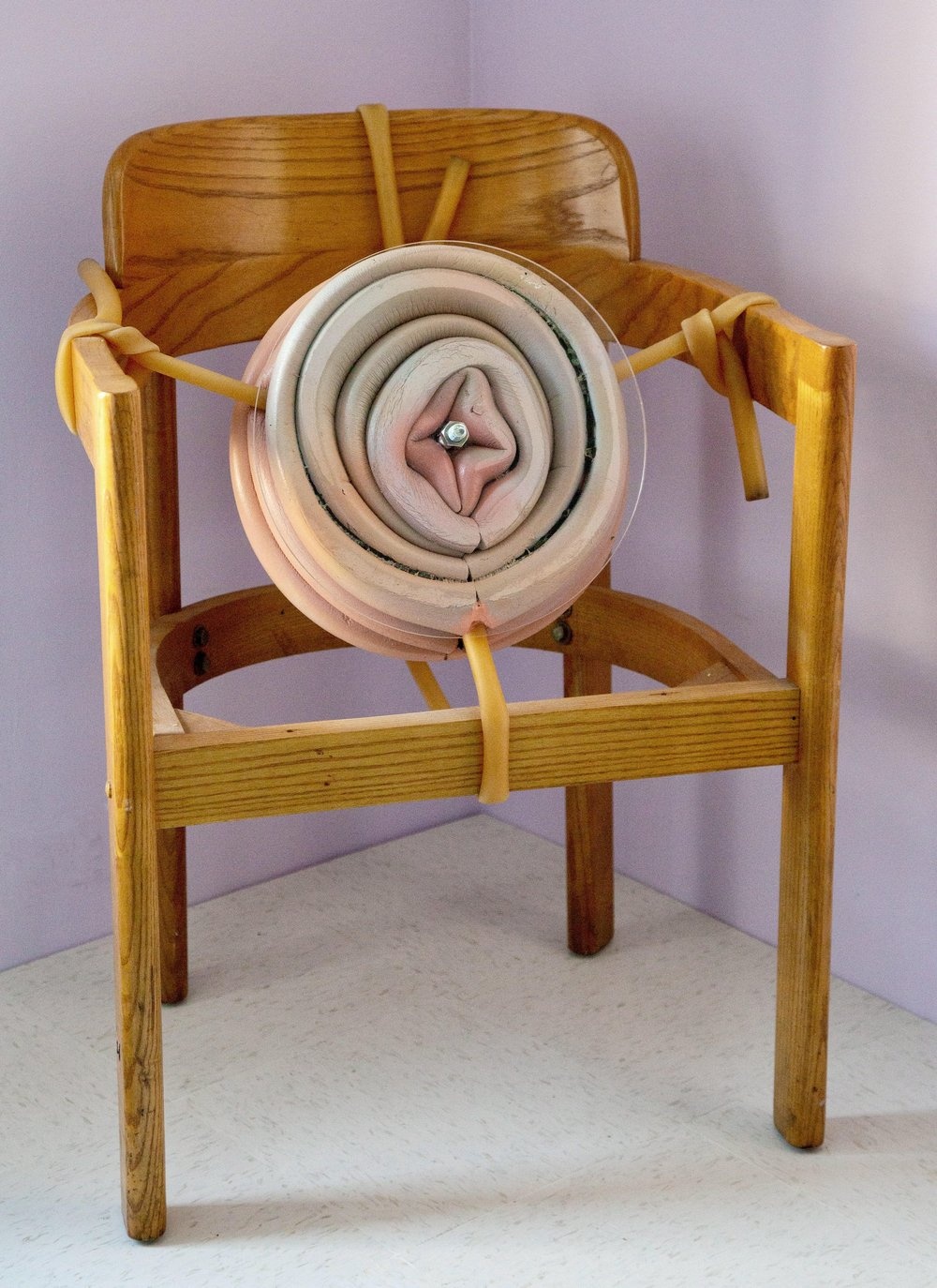
Lydia Nobles, “Lydia,” 2019
Nobles’ sculptural vocabulary “speaks” in what I would like to call the “symbolical tongue” of unembarrassed feminism, revivifying the relationship of sculpture to its history as commemorative representation. For it was, significantly, at the peak of the feminist second wave that the limits of the medium of sculpture were reasserted to eliminate even the “hint” of narrative action that Lessing attributed to “the most pregnant moment.” In her influential essay “Sculpture in the Expanded Field” (1979), Rosalind Krauss argued that sculpture was no longer pregnantly silent, but necessarily speechless, disinterested in its liminal relationship to poetry, and committed to the inimitable means of its medium. Krauss dismissed what she called sculpture’s “symbolical tongue,” which historically had authorized it “to sit” in a particular place and “to speak” about the meaning of that place. This symbolical tongue has since remained silenced, in works and in historiographies that privilege the medium’s refinement to abstract, “largely self-referential” works that look like a “pure marker or base.” [12]
Sitting with the importunate problems of the present day, Nobles’ work talks back to this history and tradition. Unlike many contemporaries, Nobles does not resort to figural representation when addressing abortion. But nor does she, in the tradition valorized since Krauss, resort to the formal abstraction of bases, plinths, or stelae, which arguably carry on an evacuated tradition of monumental art. Rather, Nobles gives us sculptural seats, stools, benches, and chairs that maintain the mark of passionately, painfully, exuberantly inclined bodies. Her sculptural vocabulary rotates the axes of what stands for an “action,” or for a “body in space.” Nobles’ most recent work lays emphasis on the underlying labor, affect, and expressivity of hands. Cast in pale amber glass with veins of bright green and touches of pink, two partial hands cup a corpulent mound in Amorphous 1 (2024). A sibling piece, Deliquesce (2024), presents this amorphous touch in just a slice of glass. In Freeze Thrust (2024), clenched fingers cast in milky blue glass breach a fragile opening in a black twist of acrylic latex and rubber, dusted in glittering pigment. Nobles assembles these new works fittingly under the title “Body Lies.” [13]
Caroline Lillian Schopp is an assistant professor of modern and contemporary art at Johns Hopkins University. Her book In-Action: Viennese Actionism and the Passivities of Performance Art is forthcoming with the University of Chicago Press.
Image credit: Courtesy of the artist
Notes
| [1] | Eighteen of the nineteen sculptures were exhibited in New York City at Ross-Sutton Gallery (October 22–November 8, 2022) in “As I Sit Waiting,” curated by Destinee Ross-Sutton. Selected sculptures from the series have been shown in “In the Waiting Room” for KAPOW at the SPRING/BREAK Art Show (September 2023), curated by Kourosh Mahboubian, and at ArtCrawl Harlem (June 2024), curated by Ulysses Williams, amongst many other venues. Some of the interviews are collected online on YouTube and linked under the “Storytellers” tab of the archive dedicated to As I Sit Waiting. See the project website. |
| [2] | The complete original text is made available by Project Gutenberg: Gotthold Ephraim Lessing, Laokoon: Oder, Über die Grenzen der Malerei und Poesie (1776). For Lessing’s most concise elaboration of the distinct means and capacities of the lyric and visual arts, cited above, see Chapter 16. For the discussion of Laocoön and His Sons cited above, see Chapter 5. For “the most pregnant moment” (den prägnantesten Augenblick), see Chapter 16 as well as Chapter 19. All citations of Lessing are taken from this edition. Translations are my own. |
| [3] | Lucy R. Lippard, “Eccentric Abstraction,” Art International 10, no. 9 (November 1966): 34. Nobles’s work also finds good company amongst “abstract bodies,” David J. Getsy’s phrase for sculptures that commit to non-reference while at the same time exploring “metaphors of the body, of sexuality, and of personhood.” Abstract Bodies: Sixties Sculpture in the Expanded Field of Gender (New Haven, CT: Yale University Press, 2015), 4. |
| [4] | Supreme Court of the United States, “Syllabus: Dobbs, State Health Officer of the Mississippi Department of Health, et al. v. Jackson Women’s Health Organization et al.,” argued December 1, 2021 – decided June 24, 2022. |
| [5] | See Idaho Statutes, Title 18 Crimes and Punishments, Chapter 87 No Public Funds for Abortion Act, Section 18-8705; Lydia Nobles, “An Idaho College Removed my Abortion-Related Art, Strengthening My Resolve to Tell These Stories,” The Art Newspaper, April 11, 2023. |
| [6] | Lydia Nobles interviewed by the AWT Editors, “Lydia Nobles’ As I Sit Waiting Amplifies the Conversation Around Abortion Rights,” A Women’s Thing, November 13, 2022, online here. |
| [7] | Nobles interviewed by the AWT Editors, “Lydia Nobles’ As I Sit Waiting.” |
| [8] | William Faulkner, As I Lay Dying [1930], Norton Critical Edition, ed. Michael Gorra (New York: Norton, 2010), 35; on Cash’s leg, see 120–21. |
| [9] | Heather E. Holcombe, “Faulkner on Feminine Hygiene, or, How Margaret Sanger Sold Dewey Dell a Bad Abortion,” Modern Fiction Studies 57, no. 2 (Summer 2011): 213. |
| [10] | Faulkner, As I Lay Dying, 115–19, 139–43, and 144–45. |
| [11] | Joan Didion, Play It As It Lays [1970] (London: Harper, 2017), 10, 60, 100, 62, 70, 81–82, and 83. |
| [12] | Rosalind Krauss, “Sculpture in the Expanded Field,” October 8 (Spring 1979): 33, 34. |
| [13] | “Body Lies” was curated by Kourosh Mahboubian at KAPOW in New York City (April 12–May 4, 2024). |
